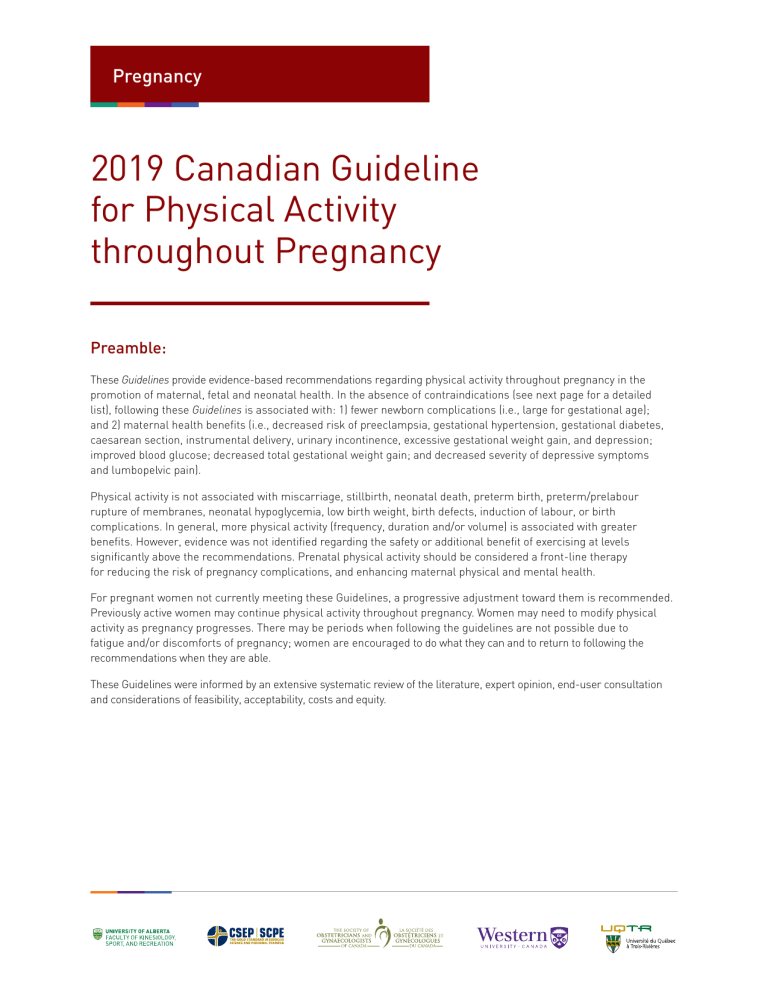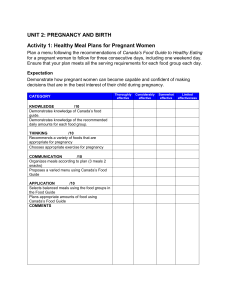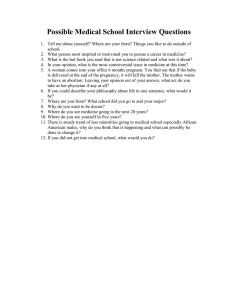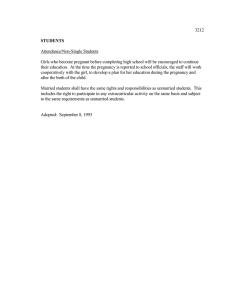
Pregnancy 2019 Canadian Guideline for Physical Activity throughout Pregnancy Preamble: These Guidelines provide evidence-based recommendations regarding physical activity throughout pregnancy in the promotion of maternal, fetal and neonatal health. In the absence of contraindications (see next page for a detailed list), following these Guidelines is associated with: 1) fewer newborn complications (i.e., large for gestational age); and 2) maternal health benefits (i.e., decreased risk of preeclampsia, gestational hypertension, gestational diabetes, caesarean section, instrumental delivery, urinary incontinence, excessive gestational weight gain, and depression; improved blood glucose; decreased total gestational weight gain; and decreased severity of depressive symptoms and lumbopelvic pain). Physical activity is not associated with miscarriage, stillbirth, neonatal death, preterm birth, preterm/prelabour rupture of membranes, neonatal hypoglycemia, low birth weight, birth defects, induction of labour, or birth complications. In general, more physical activity (frequency, duration and/or volume) is associated with greater benefits. However, evidence was not identified regarding the safety or additional benefit of exercising at levels significantly above the recommendations. Prenatal physical activity should be considered a front-line therapy for reducing the risk of pregnancy complications, and enhancing maternal physical and mental health. For pregnant women not currently meeting these Guidelines, a progressive adjustment toward them is recommended. Previously active women may continue physical activity throughout pregnancy. Women may need to modify physical activity as pregnancy progresses. There may be periods when following the guidelines are not possible due to fatigue and/or discomforts of pregnancy; women are encouraged to do what they can and to return to following the recommendations when they are able. These Guidelines were informed by an extensive systematic review of the literature, expert opinion, end-user consultation and considerations of feasibility, acceptability, costs and equity. Recommendations: The specific recommendations in the 2019 Canadian Guideline for Physical Activity throughout Pregnancy are provided below. 1 All women without contraindication should be physically active throughout pregnancy. Specific subgroups were examined: • Women who were previously inactive. • Women diagnosed with gestational diabetes mellitus. • Women categorized as overweight or obese (pre-pregnancy body mass index ≥25 kg/m2). 2 3 4 5 6 Pregnant women should accumulate at least 150 minutes of moderate-intensity physical activity each week to achieve clinically meaningful health benefits and reductions in pregnancy complications. Physical activity should be accumulated over a minimum of three days per week; however, being active every day is encouraged. Pregnant women should incorporate a variety of aerobic and resistance training activities to achieve greater benefits. Adding yoga and/or gentle stretching may also be beneficial. Pelvic floor muscle training (e.g., Kegel exercises) may be performed on a daily basis to reduce the risk of urinary incontinence. Instruction in proper technique is recommended to obtain optimal benefits. Pregnant women who experience lightheadedness, nausea or feel unwell when they exercise flat on their back should modify their exercise position to avoid the supine position. Contraindications: All pregnant women can participate in physical activity throughout pregnancy with the exception of those who have contraindications (listed below). Women with absolute contraindications may continue their usual activities of daily living but should not participate in more strenuous activities. Women with relative contraindications should discuss the advantages and disadvantages of moderate-tovigorous intensity physical activity with their obstetric care provider prior to participation. Absolute contraindications to exercise are the following: Relative contraindications to exercise are the following: • • • • • • • • • • • • • • • • • • • • • ruptured membranes, premature labour, unexplained persistent vaginal bleeding, placenta previa after 28 weeks gestation, preeclampsia, incompetent cervix, intrauterine growth restriction, high-order multiple pregnancy (e.g., triplets), uncontrolled Type I diabetes, uncontrolled hypertension uncontrolled thyroid disease, other serious cardiovascular, respiratory or systemic disorder. recurrent pregnancy loss, gestational hypertension, a history of spontaneous preterm birth, mild/moderate cardiovascular or respiratory disease, symptomatic anemia, malnutrition, eating disorder, twin pregnancy after the 28th week, other significant medical conditions.





